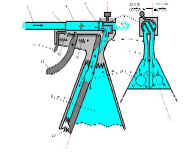- The problem to be solved:
Lung-operated aspirators provide a continuously controlled long airflow, but their use can
cause discomfort. Mechanical aspirators provide only short and pre-set airflow. Motorised
aspirators require additional energy sources, e.g. batteries.
|
- Definition:
A manually operated, manually powered aspirator device, in a pistol-like form,
for capturing and ejecting small objects, especially insects and spiders, for household
and scientific use.
|
- Presentation:
The device consists of a catching tube (1), a flap-door (2), a transparent
collection chamber (3) with a sieve (4), a direction switch (5), a flexible suction tube
(6), a flexible blow-tube (7), two pumps (8) with two check valves (9) on both pumps,
three springs (10), a pumping arm (11), and a trigger (12). Pressing or releasing the
pumping arm makes one pump expanded and the other one compressed at the same time.
Alternating the movements of the pumping arm generates a continuous airflow in the
catching tube and the collection chamber. Accelerating or decelerating the movements
regulates the air speed. The position of the direction switch determines whether the air
moves into or out of the catching tube and the collection chamber. The direction of the
airflow is constant in the suction tube and the blow tube. When the direction switch is in
the “suck” position, the suction tube is connected with the collecting chamber and the
blow tube directly with the atmosphere. The insect is drawn into the collection chamber
through the catching tube by the vacuum and it is stopped by the sieve. The “blow”
position creates the opposite situation: the captured insect is ejected from the
collection chamber through the catching tube. When high aiming precision is required,
overpressing the pumping arm fixes the pumps and enables triggering.

|
- Application:
It can be used in households to remove or exterminate insects and spiders without using
chemicals or marking the wall. The scientific application is to collect arthropods or
other objects from contaminated surfaces. It can also be used as a toy gun to suck in and
shoot out small balls.
|
- Advantages:
The device is non-motorised, comfortable and one-handed. The airflow can be either long
and controlled (e.g. to vacuum many ants), or short, pre-set and triggered (e.g. to
capture flies). The direction of the airflow is alterable, so that the captured insects
can be blown out.
|
- Stage of development: Prototype
|
- Documentation available:
Yes
|
The inventor(s)
- Self introduction:
I was born in Miskolc (Hungary) in 1969. I obtained my Ph.D. degree from the role of
spiders in pest control. I research and teach pest management at the Szent István
University, Faculty of Agricultural and Environmental Sciences, Department of Plant
Protection, Gödöllő.
|
The protection
- Form: Exhibition priority
- Priority: 04.05.2000
- Countries where it is force:
|
Business intention: Search for
manufacturer.
|
Contact
- Name: Dr. Ferenc TÓTH, Szent István
University, Faculty of Agricultural and Environmental Sciences, Department of Plant
Protection
- E-mail: tothf@fau.gau.hu
- Fax: +36 28- 522 077
- Address: , H-2103 Gödöllő, Páter K. u.
1. Hungary
|